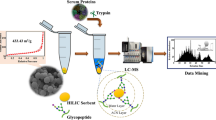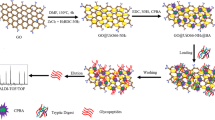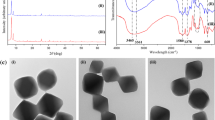Abstract
A hydrophilic terpolymer MOF composite is designed with high surface area and porosity to enrich mono- and multi-glycosylated peptides facilitating a bottom-up approach. Terpolymer@ZIF-8 is synthesized using free radical polymerization followed by layer by layer ZIF-8 fabrication. Subsequent surface modification was made by aminophenylboronic acid (AMBA). The enrichment ability of terpolymer@ZIF-8@BA is evaluated by using tryptic digest of IgG and HRP to exemplify mono- and multi-glycosylated protein samples. Improved selectivity of 1:200 for spiked HRP in BSA digest and sensitivity down to 1 fmol μL−1 is achieved. Batch to batch reproducibility is better 1% RSD which favors the adoption of the developed method for routine N-linked glycopeptide/protein determination. Cost-effective nature of given approach is given by regeneration of the material up to four cycles. Total 318 N-linked glycopeptides have been identified from 1 μL human serum digest after subjecting the enriched and PNGase-treated deglycosylated peptides to LC-MS. Thus, terpolymer@ZIF-8@BA holds the potential both for mono- and multi-glycosylated peptides from complex biological sample.





Similar content being viewed by others
References
Xu C, Ng DT (2015) Glycosylation-directed quality control of protein folding. Nat Rev Mol Cell Biol 16(12):742–752
Chen M, Shi X, Duke RM, Ruse CI, Dai N, Taron CH, Samuelson JC (2017) An engineered high affinity Fbs1 carbohydrate binding protein for selective capture of N-glycans and N-glycopeptides. Nat Commun 8:15487
Lazarus MB, Nam Y, Jiang J, Sliz P, Walker S (2011) Structure of human O-GlcNAc transferase and its complex with a peptide substrate. Nature 469(7331):564–567
Christiansen MN, Chik J, Lee L, Anugraham M, Abrahams JL, Packer NH (2014) Cell surface protein glycosylation in cancer. Proteomics 14(4–5):525–546
Liu Q, Deng CH, Sun N (2018) Hydrophilic tripeptide-functionalized magnetic metal–organic frameworks for the highly efficient enrichment of N-linked glycopeptides. Nanoscale 10(25):12149–12155
Toghi Eshghi S, Shah P, Yang W, Li X, Zhang H (2015) GPQuest: a spectral library matching algorithm for site-specific assignment of tandem mass spectra to intact N-glycopeptides. Anal Chem 87(10):5181–5188
Yao J, Sun N, Deng C (2018) Recent advances in mesoporous materials for sample preparation in proteomics research. Trends Anal Chem 99:88–100
Sajid MS, Jabeen F, Hussain D, Ashiq MN, Najam-ul-Haq M (2017) Hydrazide-functionalized affinity on conventional support materials for glycopeptide enrichment. Anal Bioanal Chem 409(12):3135–3143
Liu Y, Fu D, Yu L, Xiao Y, Peng X, Liang X (2016) Oxidized dextran facilitated synthesis of a silica-based concanavalin a material for lectin affinity enrichment of glycoproteins/glycopeptides. J Chromatogr A 1455:147–155
Yao J, Wang J, Sun N, Deng C (2017) One-step functionalization of magnetic nanoparticles with 4-mercaptophenylboronic acid for a highly efficient analysis of N-glycopeptides. Nanoscale 9(41):16024–16029
Zhang S, Tang Y, Chen Y, Zhang J, Wei Y (2020) Boronic acid-modified polyhedral oligomeric silsesquioxanes on polydopamine-coated magnetized graphene oxide for selective and high-capacity extraction of the catecholamines epinephrine, dopamine and isoprenaline. Microchim Acta 187(1):77
Saleem S, Sajid M S, Hussain D, Jabeen F, Najam-ul-Haq M, & Saeed A (2020. Boronic acid functionalized MOFs as HILIC material for N-linked glycopeptide enrichment. Anal Bioanal Chem 1-12
Liu L, Zhang Y, Zhang L, Yan G, Yao J, Yang P, Lu H (2012) Highly specific revelation of rat serum glycopeptidome by boronic acid-functionalized mesoporous silica. Anal Chim Acta 753:64–72
Sajid MS, Jovcevski B, Pukala TL, Jabeen F, Najam-ul-Haq M (2019) Fabrication of piperazine functionalized polymeric monolithic tip for rapid enrichment of glycopeptides/glycans. Anal Chem
Sajid MS, Jabeen F, Hussain D, Gardner QTAA, Ashiq MN, Najam-ul-Haq M (2020) Boronic acid functionalized fibrous cellulose for the selective enrichment of glycopeptides. J Sep Sci 43:1348–1355
Li H, Xie T, Ye L, Wang Y, Xie (2017) Core-shell magnetic molecularly imprinted polymer nanoparticles for the extraction of triazophos residues from vegetables. Microchim Acta 183:2677–2695
Yu L, Li X, Guo Z, Zhang X, Liang X (2009) Hydrophilic interaction chromatography based enrichment of glycopeptides by using click maltose: a matrix with high selectivity and glycosylation heterogeneity coverage. Chem Eur J 15(46):12618–12626
Ma W, Xu L, Li Z, Sun Y, Bai Y, Liu H (2016) Post-synthetic modification of an amino-functionalized metal–organic framework for highly efficient enrichment of N-linked glycopeptides. Nanoscale 8(21):10908–10912
Saeed A, Hussain D, Saleem S, Mehdi S, Javeed R, Jabeen F, Najam-ul-Haq M (2019) Metal–organic framework-based affinity materials in proteomics. Anal Bioanal Chem 411(9):1745–1759
Furukawa H, Ko N, Go YB, Aratani N, Choi SB, Choi E, Yaghi OM (2010) Ultrahigh porosity in metal-organic frameworks. Science 329(5990):424–428
Mohyuddin A, Hussain D, Fatima B, Athar M, Ashiq MN, Najam-ul-Haq M (2019) Gallic acid functionalized UiO-66 for the recovery of ribosylated metabolites from human urine samples. Talanta 201:23–32
Gu X, Lu ZH, Jiang HL, Akita T, Xu Q (2011) Synergistic catalysis of metal–organic framework-immobilized Au–Pd nanoparticles in dehydrogenation of formic acid for chemical hydrogen storage. J Am Chem Soc 133(31):11822–11825
Hu YL, Liao J, Wang DM, Li GK (2014) Fabrication of gold nanoparticle-embedded metal-organic framework for highly sensitive surface-enhanced raman scattering detection. Anal Chem 86:3955–3963
Zlotea C, Campesi R, Cuevas F, Leroy E, Dibandjo P, Volkringer C, Latroche M (2010) Pd nanoparticles embedded into a metal-organic framework: synthesis, structural characteristics, and hydrogen sorption properties. J Am Chem Soc 132(9):2991–2997
Bux H, Liang F, Li Y, Cravillon J, Wiebcke M, Caro J (2009) Zeolitic imidazolate framework membrane with molecular sieving properties by microwave-assisted solvothermal synthesis. J Am Chem Soc 131(44):16000–16001
Mohyuddin A, Hussain D, Najam-ul-Haq M (2017) Polydopamine assisted functionalization of boronic acid on magnetic nanoparticles for the selective extraction of ribosylated metabolites from urine. RSC Adv 7(16):9476–9483
Gudelj I, Lauc G, Pezer M (2018) Immunoglobulin G glycosylation in aging and diseases. Cell Immunol 333:65–79
Zhang YW, Li Z, Zhao Q, Zhou YL, Liu HW, Zhang XX (2014) A facilely synthesized amino-functionalized metal–organic framework for highly specific and efficient enrichment of glycopeptides. ChemComm 50(78):11504–11506
Lin H, Shao X, Lu Y, Deng C (2018) Preparation of iminodiacetic acid functionalized silica capillary trap column for on-column selective enrichment of N-linked glycopeptides. Talanta 188:499–506
Li S, Li D, Sun L, Yao Y, Yao C (2018) A designable aminophenylboronic acid functionalized magnetic Fe3O4/ZIF-8/APBA for specific recognition of glycoproteins and glycopeptides. RSC Adv 8(13):6887–6892
Sun N, Wang J, Yao J, Chen H, Deng C (2019) Magnetite nanoparticles coated with mercaptosuccinic acid-modified mesoporous titania as a hydrophilic sorbent for glycopeptides and phosphopeptides prior to their quantitation by LC-MS/MS. Microchim Acta 186(3):159
Shen YF, Yuan FF, Liu XY, Huang YP, Liu ZS (2019) Synergistic effect of organic-inorganic hybrid monomer and polyhedral oligomeric silsesquioxanes in a boronate affinity monolithic capillary/chip for enrichment of glycoproteins. Microchim Acta 186(12):812
Sun N, Wu H, Shen X (2020) Magnetic titanium dioxide nanomaterial modified with hydrophilic dicarboxylic ligand for effective enrichment and separation of phosphopeptides and glycopeptides. Microchim Acta 187(3):1–8
Saldova R, Royle L, Radcliffe CM, Abd Hamid UM, Evans R, Arnold JN, Banks RE, Hutson R, Harvey DJ, Antrobus R, Petrescu SM, Dwek RA, Rudd PM (2007) Ovarian cancer is associated with changes in glycosylation in both acute-phase proteins and IgG. Glycobiology 17(12):1344–1356. https://doi.org/10.1093/glycob/cwm100
Liu JX, Yuan Q, Min YL, He Y, Xu QH, Li B, Shi WQ, Lin Q, LiQ H, ZhuP W, Shao Y (2019) Apolipoprotein A1 and B as risk factors for development of intraocular metastasis in patients with breast cancer. Cancer Manag Res 11:2881–2888
Funding
This work was supported by Higher Education Commission (HEC) of Pakistan.
Author information
Authors and Affiliations
Corresponding author
Ethics declarations
Conflict of interest
The authors declare that they have no conflict of interest.
Ethical statement
Serum samples were obtained from anonymous healthy males from the local hospital in accordance with government regulations and approved by the Ethical Advisory Board, Pakistan.
Additional information
Publisher’s note
Springer Nature remains neutral with regard to jurisdictional claims in published maps and institutional affiliations.
Electronic supplementary material
ESM 1
(DOCX 1.98 mb)
Rights and permissions
About this article
Cite this article
Saleem, S., Sajid, M.S., Hussain, D. et al. Highly porous terpolymer-ZIF8@BA MOF composite for identification of mono- and multi-glycosylated peptides/proteins using MS-based bottom-up approach. Microchim Acta 187, 555 (2020). https://doi.org/10.1007/s00604-020-04532-z
Received:
Accepted:
Published:
DOI: https://doi.org/10.1007/s00604-020-04532-z




